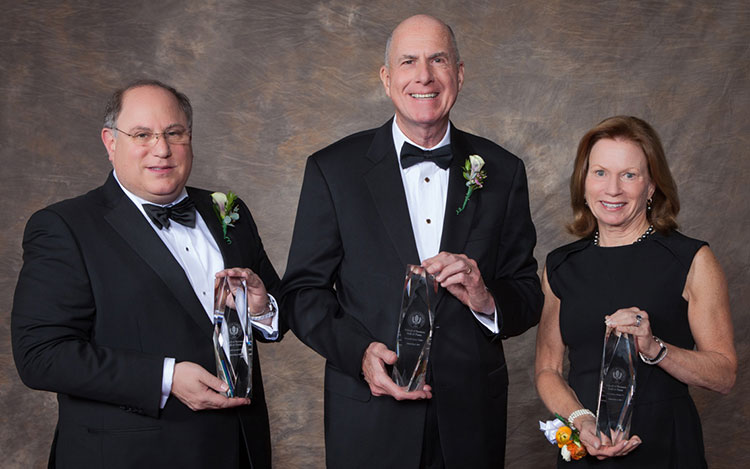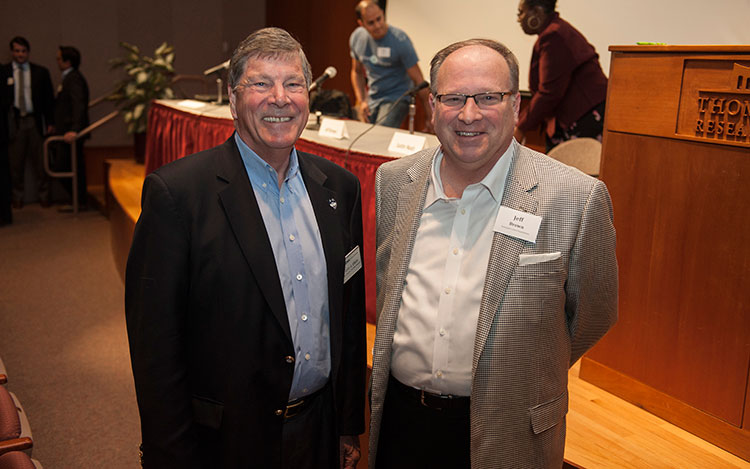WHPX-TV – Michael Zacchea ’12 MBA, discusses UConn’s Entrepreneurship Bootcamp for Veterans with Disabilities in an interview with Shawn Murphy on ‘For The Record.’ Airing July 14.
CCEI
Til Duty is Done
Retired U.S. Army Captain /UConn Alumnus Building Housing, Haven for Returning Veterans
Every class that graduates from the U.S. Military Academy at West Point adopts a creed that unifies and guides the future officers during their military training.
For U.S. Army Capt. Justin Nash, and the rest of the Class of 2001, that principle was: Til Duty is Done.
That powerful phrase has been a rallying cry for Nash, who several years later led a platoon of professional soldiers and 300 indigent Afghan warriors through a series of harrowing missions near the Pakistani border.Continue Reading
EBV Program Receives Boost from Bank of America
Bank of America to Support Initiative for Veterans
UConn’s Entrepreneurship Boot Camp for Veterans with Disabilities (EBV) has received a $15,000 grant from the Bank of America Foundation.
The grant will support UConn’s program in the School of Business that provides disabled veterans with training in entrepreneurship and small business management, the UConn Foundation, which applied for the grant, announced.Continue Reading
Business Hall of Fame Induction

Alumni Say Though Campus Has Changed, the Camaraderie at UConn Remains the Same
The School of Business welcomed four new members to its Hall of Fame and paid tribute to veterans of the U.S. Armed Services in a May 8 ceremony at the Connecticut Convention Center in Hartford.
Among the inductees were: David B. Greenfield ’84; Norman W. Lacroix ’72 MBA, Wendy Reeves Watkins ’74. The late Brigadier Gen. James S. Creedon ’53 was inducted posthumously.
Dean John A. Elliott noted that this year’s inductees have not only achieved tremendous success in their careers, but have made a personal commitment to the betterment of their communities by advocating for and supporting higher education, theaters and museums, food banks and many other deserving institutions.Continue Reading
Creating a Better World

Mission-Focused Businesses Subject of Recent Conference
Business partners Spencer Curry and Kieran Foran go to work at their FRESH Farm Aquaponics business in South Glastonbury every day, believing they’re one step closer to solving world hunger.
When Justin Nash was a Captain in the U.S. Army in Afghanistan, his soldiers looked to him for guidance. Now a civilian, he’s using those leadership traits at Til Duty is Done, an organization he created which seeks to provide housing, employment training and career opportunities for returning veterans. Til Duty is Done, Nash said, gives him a renewed sense of purpose.Continue Reading
‘Accelerate UConn’ Begins
New Program Prepares to Welcome Inaugural Teams of Inventors
The University of Connecticut is launching a new program, called Accelerate UConn, which will encourage and fund student and faculty teams interested in developing technology-focused start-up companies.
The program is made possible by a $100,000, one-year grant from the National Science Foundation Innovation Corps (I-Corps), that may be extended for two additional years.Continue Reading
Social Enterprise Conference
School of Business’ Social Enterprise Conference Attracting Leading Scholars, Entrepreneurs and Business Owners
“We don’t hire people to bake brownies, we bake brownies to hire people,” boasts the website of Greyston Bakery of Yonkers, N.Y.
Recognized as one of the best social enterprise companies in the world, Greyston Bakery’s mission is to provide individuals with employment, skills and resources to lift them out of poverty.Continue Reading
UConn School of Business Among Military Times’ Best for Veterans
 The UConn School of Business is among the “Best for Veterans—Business Schools 2015” according to a report released Monday by Military Times.
The UConn School of Business is among the “Best for Veterans—Business Schools 2015” according to a report released Monday by Military Times.
UConn ranked No. 54 nationally, in a year that saw record applications and a process that was highly competitive. It is one of many recognitions that the University has received for its veteran programs, which include an Entrepreneurship Bootcamp for Veterans with Disabilities (EBV). Last year, the UConn EBV and School of Business were recognized by Newman’s Own Foundation as one of the five best veteran non-profit organizations in the country.
Students Enter Their “Stay-Up-All-Night-Working-On-It’’ Projects In Hopes of Becoming UConn’s Innovation Quest Champ
Have you ever tried to buy concert- or theater- tickets online and been asked to retype two words, which are displayed in squashed, blurry, italic font that is virtually impossible to distinguish?
If you’re like Theo Marrinan, that hurdle absolutely drives you nuts. Marrinan has a plan that will make that task a little easier, a great deal more fun, and may also be intriguing to advertisers who could use it to promote their product.
‘The Doors are Open to Anyone with Ideas’ University Leaders Say that Student Entrepreneurship is on the Fast Track
When Management Professor Rich Dino started a course that helps non-business majors write a business plan, it filled almost instantly. He scheduled two more classes, and the same thing happened.
“This semester I have students majoring in everything from physics to music, and their different views enhance the class,” Dino said. “The doors are open to anyone with ideas.”Continue Reading

